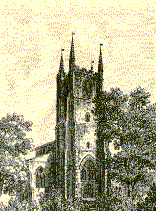
Bred, Wed and Dead in bygone Croydon
Since 1538 every parish in England has been required by law to keep a register of baptisms, marriages and burials.
Croydon is one of only 14 Surrey parishes that can claim to have a complete run of registers from this date.
The information these old documents provide is invaluable to the family historian in tracking down where and when their forebears were "bred, wed and dead".

Image: Croydon parish church in 1792. Illustration from Lyson's History of Croydon.
In 1792, Daniel Lysons, the famous antiquarian, published the Surrey volume of his history of The Environs of London which contains a chapter on Croydon.
This has been reprinted by Local History Publications as Lysons's History of Croydon. This book includes a fascinating account of various entries that are to be found in the parish registers.
When Lysons visited Croydon in the early 1790s it was a small market town surrounded by open countryside. It consisted of around 800 buildings with an estimated population of 4,800.
As Lysons examined the parish registers the first thing that struck him was the "great neatness and accuracy" of the entries, particularly those recorded during the incumbency of Dr East Apthorpe who was vicar of Croydon from 1765 until his resignation in 1793.
Over the centuries the increasing number of baptisms show the steady increase in the population of the town.
In the 10 years commencing 1580 an average of 67 persons were baptised each year. However, two hundred years later in the decade commencing 1780 this had more than doubled to an average of over 150 per annum.
Sadly not all the births recorded were happy occasions. Many mothers died during labour and numerous babies passed away shortly after they were born.
The registers record what is described as "a monstrous birth" which took place in Croydon on 27th January 1722. This entry obviously refers to Siamese twins who were "born of the body of Rose Eastman, wife of John Eastman, being a child with two heads, four arms, four legs, one body, one navel, and distinction of two male children."
Although Croydon was many miles from the centre of London the effects of the great plague of 1665/6 still took its toll on the local inhabitants. 141 deaths are detailed between 27 July 1665 and 22 March 1666.
However, this was not the only outbreak of plague to have afflicted the town. Between 20 July 1603 and 16 April 1604, 158 Croydon residents died of the disease. A note in the registers advised that "from the llth to the 18th August 1603, 3,054 people died of the plague in London, and the liberties thereof, and that many died in the highways near about the citie;" and that, "from the 25th August to the 1st September, 3,385 people died." Smaller outbreaks of plague occurred in Croydon in subsequent years claiming 76 deaths in 1625; 24 in 1626 and 74 in 1631.
If the grim reaper cut life short for many in the plague years others were blessed with long lives. Five centenarians were buried in Croydon churchyard between 1633 and 1771 with Margaret Ford being the oldest at 105 when she was laid to rest on the 2nd February 1715.
Lysons's History of Croydon costs £3.35 including postage and packing and is available from Local History Publications, 316 Green Lane, Streatham, London SW16 3AS